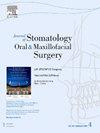Four decades of treatment for actinic cheilitis: Outcomes, challenges, and the introduction of a new clinical index
IF 2
3区 医学
Q2 DENTISTRY, ORAL SURGERY & MEDICINE
Journal of Stomatology Oral and Maxillofacial Surgery
Pub Date : 2025-01-08
DOI:10.1016/j.jormas.2025.102227
引用次数: 0
Abstract
Objective
To evaluate the clinical outcomes of surgical and non-surgical treatments for actinic cheilitis (AC) over a four-decade period and to introduce a novel Clinical Index for the Treatment and Control of Actinic Cheilitis (CITC-AC) for improved patient stratification and management.
Materials and Methods
A retrospective cohort study analyzed 151 patients diagnosed with AC treated at a university clinic between 1980 and 2020. Sociodemographic, clinical, and histopathological data were collected. Treatments were categorized as sun protection (SP), topical corticosteroids (TC), surgical removal (SR), and vermilionectomy. Therapeutic outcomes, recurrence rates, and malignant transformation were assessed. The CITC-AC was developed to guide clinical decision-making based on stratified risk.
Results
A total of 87% of patients achieved therapeutic resolution. Recurrence was observed in 13%, and malignant transformation occurred in 7% of cases. Surgical treatments, particularly vermilionectomy, demonstrated superior outcomes with no recurrence or malignancy. Non-surgical treatments, including the novel use of Omcion-A Orabase, achieved favorable outcomes but exhibited higher recurrence rates. The CITC-AC provided a structured framework for stratifying patients by severity and risk, aiding in the selection of appropriate interventions and follow-up schedules.
Conclusions
This study highlights the importance of individualized treatment strategies and consistent follow-up in AC management. While surgical interventions remain the gold standard for advanced cases, non-surgical treatments are effective for early-stage lesions. The CITC-AC offers a practical tool for optimizing patient care and reducing progression to squamous cell carcinoma (SCC). Prospective studies are needed to validate its applicability across diverse clinical settings.
光化性口炎治疗的四十年:结果、挑战和新临床指标的引入。
目的:评价近40年来光化性口炎(AC)手术和非手术治疗的临床效果,并提出一种新的光化性口炎治疗和控制临床指标(CITC-AC),以改善患者分层和管理。材料和方法:一项回顾性队列研究分析了1980年至2020年间在一所大学诊所接受治疗的151名确诊为AC的患者。收集了社会人口学、临床和组织病理学数据。治疗方法分为防晒(SP)、外用皮质类固醇(TC)、手术切除(SR)和朱砂切除术。评估治疗结果、复发率和恶性转化。CITC-AC的开发是为了指导基于分层风险的临床决策。结果:87%的患者获得治疗缓解。复发率为13%,恶性转化率为7%。手术治疗,特别是朱砂切除术,表现出良好的预后,无复发或恶性肿瘤。非手术治疗,包括新使用的Omcion-A Orabase,取得了良好的结果,但表现出较高的复发率。CITC-AC提供了一个结构化的框架,根据严重程度和风险对患者进行分层,有助于选择适当的干预措施和随访计划。结论:本研究强调了个体化治疗策略和持续随访在AC治疗中的重要性。虽然手术干预仍然是晚期病例的金标准,但非手术治疗对早期病变有效。CITC-AC为优化患者护理和减少鳞状细胞癌(SCC)的进展提供了一个实用的工具。需要前瞻性研究来验证其在不同临床环境中的适用性。
本文章由计算机程序翻译,如有差异,请以英文原文为准。
求助全文
约1分钟内获得全文
求助全文
来源期刊

Journal of Stomatology Oral and Maxillofacial Surgery
Surgery, Dentistry, Oral Surgery and Medicine, Otorhinolaryngology and Facial Plastic Surgery
CiteScore
2.30
自引率
9.10%
发文量
0
审稿时长
23 days
 求助内容:
求助内容: 应助结果提醒方式:
应助结果提醒方式:


